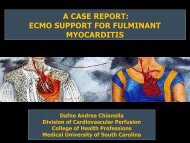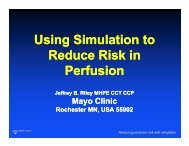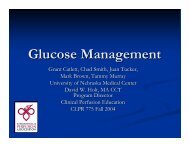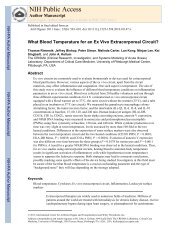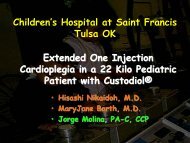PowerPoint Presentation (PDF) - Perfusion.com
PowerPoint Presentation (PDF) - Perfusion.com
PowerPoint Presentation (PDF) - Perfusion.com
You also want an ePaper? Increase the reach of your titles
YUMPU automatically turns print PDFs into web optimized ePapers that Google loves.
Alicia Sievert, MS, CCP, Joseph Sistino, MS, MPA, CCP, Sean Wittorf<br />
Medical University of South Carolina, Charleston, SC<br />
March 10, 2011
Pulse Pressure > 15 mmHg<br />
Defining PP<br />
Energy Equivalent Pressure (EEP) (Shepard)<br />
Ratio between the area beneath the hemodynamic power curve (∫fpdt)<br />
and area beneath the pump flow curve (∫fdt) during each pulse cycle:<br />
EEP = (∫fdpt)/(∫fdt)<br />
where f = pump flow rate,<br />
p = arterial pressure<br />
dt = change in time at the end of flow and pressure cycles<br />
The difference between EEP and MAP = the extra energy generated<br />
(physiologic pulse ~10-12%)
Choosing the Right Equipment<br />
Up to 80% of energy created is<br />
dampened by circuit <strong>com</strong>ponents<br />
• Oxygenators with a lower<br />
pressure drop<br />
• Aortic cannulas with shorter<br />
tips and a lower pressure drop<br />
Wang et al. Hemodynamic Energy Delivery of the Pulsatile Flow in a<br />
Simulated Pediatric Extracorporeal Circuit, ASAIO. 2009;55:96-99.
Common Settings on Roller Head Pumps<br />
• Adults<br />
• Peds<br />
• BPM 80<br />
• Amplitude 70-80%<br />
• Base 20-30%<br />
• BPM 100-150<br />
• Amplitude 70%<br />
• Base 30%<br />
Initiated during XC<br />
How to Pulse<br />
May also use IABP set to internal 80 BPM during XC
Advantages of Pulsatile <strong>Perfusion</strong><br />
Better organ<br />
preservation<br />
SIRS<br />
•Improved cerebral perfusion<br />
•Promotion of metabolic<br />
exchange<br />
•↑ urine output<br />
•↓ inotropic support/ Better<br />
myocardial function<br />
•↓ pulmonary edema<br />
•↓ intubation times<br />
•↓ lactate levels<br />
• ↓ endothelial damage<br />
• Lower C-reactive protein &<br />
cytokine levels<br />
• ↓ capillary leak<br />
Endocrine<br />
system<br />
response<br />
Temp<br />
Management<br />
• ↓ Plasma vasopressin<br />
• ↓ Thyroid hormone<br />
• ↓ Adrenocortical hormone<br />
• ↓ Cortisol<br />
• ↓ Cathecholamines<br />
• ↓ Rennin & angiotensin II<br />
• ↓ Thromboxane<br />
• More even warming & cooling
Disadvantages of Pulsatile <strong>Perfusion</strong><br />
Difficulty<br />
Hemolysis<br />
Gaseous<br />
microemboli<br />
production<br />
• Reluctant acceptance of surgical team<br />
• Proper equipment – pumps,<br />
oxygenators, cannulae<br />
• Higher circuit pressure<br />
• Cavitation during negative pressure<br />
phase of pulse cycle
Purpose<br />
To determine if there is a significant difference in<br />
post-operative renal function with pulsatile<br />
perfusion verses non-pulsatile perfusion during<br />
cardiac surgery.
Methods<br />
PubMed Search: (National Library of Medicine) 1990-present<br />
• Keywords – “pulsatile perfusion, pulse, pulsatile flow<br />
and cardiopulmonary bypass/cardiac surgery”<br />
Inclusion Criteria: research articles were prospective, humans, paper<br />
contained documented baseline demographics, out<strong>com</strong>e data included<br />
renal function<br />
Statistics: Meta-analysis using Comprehensive Meta-Analysis version 2.2<br />
for Windows<br />
• A random effects model was used when there was heterogeneity of effect sizes<br />
was present
Out<strong>com</strong>e Variables<br />
Demographics<br />
• Pre-op Creatinine<br />
• CPB Time<br />
• XC Time<br />
• MAP on CPB<br />
Renal Function<br />
• Creatinine<br />
• Creatinine clearance<br />
• BUN<br />
• Lactate<br />
• SVR
Results<br />
A total of 298 articles were initially identified<br />
Ten articles met the inclusion criteria (3 Ped, 7 Adult)<br />
• Pulsatile <strong>Perfusion</strong> (PP), n = 708<br />
• Nonpulsatile <strong>Perfusion</strong> (NP), n = 477
Articles Included<br />
Article Peds/Adults Sample Size<br />
(PP/NP)<br />
Badner, 1992 Adults 27/26 Stockert<br />
Method of Pulsatility<br />
Louagie, 1992 Adults 50/50 Stockert 10-00-00<br />
Poswal, 2004 Adults 50/50 Sarns 9000<br />
Onorati, 2005 Adults 20/20 IABP<br />
Alkan, 2006 Peds 25/25 Stockert S3<br />
Alkan, 2007 Peds 151/64 Stockert S3<br />
Onorati, 2007 Adults 50/50 IABP<br />
Onorati, 2009a Adults 40/40 IABP<br />
Onorati, 2009b Adults 87/71 IABP<br />
Alkcevin, 2010 Peds 208/81 Stockert S3
Pre-op<br />
Creatinine<br />
(mg/dL)<br />
CPB Time<br />
(min)<br />
XC Time<br />
(min)<br />
MAP<br />
(mmHg)<br />
Results - Demographics<br />
PP<br />
(mean)<br />
NP<br />
(mean)<br />
Difference<br />
in Means<br />
SE Significance<br />
0.83 0.85 -0.01 0.07 ns<br />
103.65 104.23 0.11 0.1 ns<br />
65.33 64.95 0.32 0.24 ns<br />
67.4 69.2 -0.99 0.46 0.03<br />
Difference in standardized means = PP-NP
Results – Post-op Renal Function<br />
Articles n Difference<br />
in Means<br />
SE Significance<br />
Creatinine 9 1132 -0.01 0.02 ns<br />
BUN 6 415 0.68 0.53 ns<br />
SVR 5 478 0.14 0.67 ns<br />
CrCl 6 531 2.48 0.86 0.004<br />
Difference in standardized means = PP-NP
Results – Renal Function<br />
Post-operative creatinine clearance was significantly greater with pulsatile<br />
perfusion (p=0.004)<br />
Difference in standardized means = PP-NP<br />
Favors NP Favors PP
Results – Lactate<br />
There was a significant reduction in lactate levels in ICU with pulsatile<br />
perfusion (p=0.012)<br />
Difference in standardized means = PP-NP<br />
Favors PP Favors NP
Conclusion<br />
Pulsatile perfusion is beneficial in renal<br />
preservation and should be considered, especially<br />
for high risk patients<br />
Most significant findings:<br />
• Pulsatile perfusion results in<br />
• Greater creatinine clearance<br />
• Reduced post operative lactate levels
Limitations<br />
• Included pediatric and adult studies<br />
• Different methods of pulsatile flow between<br />
studies<br />
• Quantification of pulsatile perfusion not always<br />
reported<br />
• Publication bias is possible due to publication<br />
of positive results
Alicia Sievert, MS, CCP, Joseph Sistino, MS, MPA, CCP, Sean Wittorf<br />
Medical University of South Carolina, Charleston, SC<br />
March 10, 2011
Non-pulsatile <strong>Perfusion</strong> Mode Pulsatile <strong>Perfusion</strong> Mode<br />
Undar et al. Effects of perfusion mode on regional and global organ blood flow in a neonatal<br />
piglet model. Ann Thorac Surg. 1999; 68: 1336-42.



